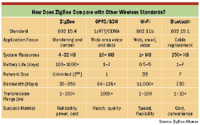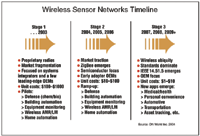In compliance with the time schedule established many months ago, the ZigBee Alliance (www.zigbee.org) has ratified the first ZigBee specification for wireless data communications. ZigBee is the only standards-based data communications protocol specifically designed to enable low-cost, low-power, wireless sensor networks. The spec finalization is the culmination of two years of worldwide development and interoperability testing by the more than 100 member companies within the ZigBee Alliance, and it promises to make wireless sensing and control networks a widespread reality. In fact, that ratification was the basis for rosy projections of wireless sensor growth that futurists and market researchers have made. For instance, ON World Inc.'s (www.onworld.com) projection of 465.58 million RF modules implemented for sensor networking by the year 2010 was based on the assumption of Q4 2004 ratification of the ZigBee spec. And by the way, ON World estimates that ZigBee-based modules will account for nearly 78% of those in existence by the end of the decade.
 How Does ZigBee Compare with Other Wireless Standards? |
The impact will be large for both end users and OEMs, says Bob Heile, chairman of the ZigBee Alliance. End users will be able to reap the benefit of many networked solutions instead of individual solutions. This means a richer experience and more capable overall systems involving lighting controls, automatic meter reading, HVAC, home security, smoke and gas detection, environmental control, medical monitoring, home control, industrial automation, commercial building automation, and other types of sensor-based monitoring and control.
The impact for OEMs is this: Those who have already released ZigBee-ready products will now be able to have their products tested for ZigBee-compliant certification. Meanwhile, the Alliance will continue to validate the specification through expanded interoperability and scalability tests and future enhancements.
Focal Points of the Standard
ZigBee is the only wireless standards-based technology that addresses the unique needs of remote monitoring and control (sensory network) applications; enables broad-based deployment of wireless networks with low-cost, low-power solutions; and provides the ability to run for years on inexpensive primary batteries for a typical monitoring application.
ZigBee-compliant products take advantage of an IEEE 802.15.4 physical radio standard and operate in unlicensed bands worldwide at 2.4 GHz (global), 915 MHz (the Americas), and 868 MHz (Europe). ZigBee enables raw data throughput rates of 250 Kbps at 2.4 GHz (16 channels), 40 Kbps at 915 MHz (10 channels), and 20 Kbps at 868 MHz (1 channel). Transmission distances range from 10 to 100 m, depending on power output and environmental characteristics.
Several of the 5 MHz channels in the 2.4 GHz band do not overlap with U.S. and European versions of IEEE 802.11 or Wi-Fi. ZigBee incorporates an IEEE 802.15.4–defined CSMA-CA protocol that reduces the probability of interfering with other users, and automatic retransmission of data ensures robustness. But, because the duty cycle of a ZigBee-compliant device is usually extremely low, relatively very few packet data units are transmitted, reducing the likelihood of an unsuccessful transmission.
ZigBee-compliant networks promise reliability. To do so, they use direct sequence spread spectrum with such features as collision avoidance, receiver energy detection, link quality indication, clear channel assessment, acknowledgement, security, support for guaranteed time slots, and packet freshness. ZigBee was designed to operate even in the hostile RF environments of typical commercial and industrial operations.
Data integrity and security were other goals in developing the ZigBee standard. So ZigBee provides a security toolbox approach to ensure reliable and secure networks. Access control lists, packet freshness timers, and 128-bit encryption based on the NIST Certified Advanced Encryption Standard help protect data transmission.
 Wireless Sensor Networks Timeline |
A FAQ page on the ZigBee Alliance Web site answers more than 30 frequently asked questions about how ZigBee compares with other standards and protocols (such as LONWorks, USB, Bluetooth, Z-Wave, X-10, Power Line Communications); how ZigBee achieves low power consumption; how it conforms with international regulations; and even how ZigBee got its name. Here's a sampling:
Q: What is the advantage of the ZigBee solution over proprietary solutions?
A: The main advantages include product interoperability, vendor independence, and accessibility to broader markets. Customers can expect increased product innovation as a result of the industry standardization of the physical radio and logical networking layers. Instead of having to invest resources to create a new proprietary solution from scratch every time, companies will now be able to leverage these industry standards to instead focus their energies on finding and serving customers.
Q: How easy is it to develop ZigBee-compliant products?
A: Companies will be able to easily and cost-effectively include ZigBee-compliant wireless networking capabilities into their products through the introduction of small, low-power, wireless RF modules. The availability of standards-based hardware and software solutions dramatically reduces the cost and complexity of integrating embedded RF into the typical product design. Vendors will provide software tool kits including profile templates, to enable OEMs and end users to efficiently create application layer solutions at low cost and reduce time to market.
Q: Is it possible to add ZigBee technology to existing appliances and other devices?
A: Yes, ZigBee can be added to existing products. As a standards-based wireless technology, ZigBee RF modules will be manufactured into multiple new product applications in 2005. Some manufacturers have included "extension connectors" into their present-day products for an upgrade path to emerging wireless technologies as ZigBee.
Gateway products are under discussion to link ZigBee with existing home, building automation, and industrial WLAN/ WPAN networks.
Q: How many nodes can a ZigBee network support?
A: ZigBee's addressing scheme is capable of supporting more than 64,000 nodes per "network coordinator," and multiple network coordinators can be linked together to support extremely large networks. The logical size of a ZigBee network ultimately depends on which frequency band is selected, how often each device on the network needs to communicate, and how much data loss or how many retransmissions can be tolerated by the application.
